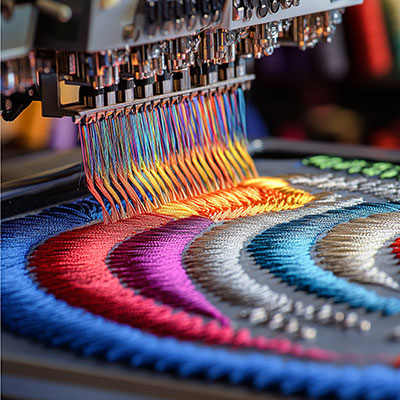Currently Empty: ₨ 0

Machine Embroidery
- Description: Automated stitching using computerized embroidery machines for precision and speed.
- Features:
- Fast production, ideal for large quantities.
- Consistent and precise designs.
- Supports complex patterns with multiple colors.
- Limited by machine hoop size (area where stitching occurs).
- Best for: Uniforms, branded apparel, and mass-produced clothing.
3. Chain Stitch Embroidery
- Description: A technique creating a chain-like pattern, often done by hand or specialized machines.
- Features:
- Distinctive, rope-like texture resembling a chain.
- Durable and bold, suitable for outlines or filling.
- Often used in vintage or retro designs.
- Best for: Denim jackets, workwear, or bohemian-style clothing.
4. Satin Stitch Embroidery
- Description: Smooth, glossy stitches that cover the fabric surface to form solid shapes.
- Features:
- Creates a shiny, flat appearance, ideal for logos and text.
- Limited to smaller designs due to stitch density.
- Can fray if not done with high-quality thread.
- Best for: Monograms, logos, and small decorative patches.
5. Cross-Stitch Embroidery
- Description: X-shaped stitches forming a grid-like pattern, often used for pictorial designs.
- Features:
- Structured, pixelated look, great for detailed images.
- Typically done on woven fabrics like Aida cloth.
- Time-consuming but beginner-friendly.
- Best for: Casual shirts, tablecloths, or folk-inspired clothing.
6. Appliqué Embroidery
- Description: Attaching fabric patches to a base fabric, secured with decorative stitching.
- Features:
- Adds texture and dimension with layered fabrics.
- Can incorporate multiple materials (e.g., cotton, leather, velvet).
- Often combined with satin or zigzag stitches to secure edges.
- Best for: Bold designs on jackets, bags, or children’s clothing.
7. 3D Puff Embroidery
- Description: Uses foam under stitching to create a raised, three-dimensional effect.
- Features:
- Bold, eye-catching designs with a tactile feel.
- Requires specialized machines and foam materials.
- Best for simple shapes due to foam limitations.
- Best for: Caps, sportswear, and streetwear logos.
8. Sequin Embroidery
- Description: Incorporates sequins or beads into stitching for a sparkly effect.
- Features:
- Adds glamour and shine, ideal for evening wear.
- Can be combined with other embroidery types for texture.
- Requires careful handling to prevent sequin detachment.
- Best for: Party dresses, dance costumes, and fashion-forward pieces.
9. Crewel Embroidery
- Description: Uses wool threads for bold, textured designs, often floral or nature-inspired.
- Features:
- Chunky, rustic appearance due to thicker threads.
- Often hand-stitched for a traditional look.
- Durable but less precise than fine-thread embroidery.
- Best for: Sweaters, scarves, or heritage-style clothing.
10. Free-Motion Embroidery
- Description: Machine embroidery where the fabric is moved manually to create freeform designs.
- Features:
- Allows artistic, sketch-like patterns.
- Requires skill to control the machine.
- Highly customizable but less uniform than programmed machine embroidery.
- Best for: Unique, painterly designs on quilts or avant-garde fashion.
11. Chenille Embroidery
- Description: Creates a fuzzy, velvet-like texture using looped threads.
- Features:
- Soft, plush appearance, often seen in retro or varsity styles.
- Best for large, bold designs due to thread thickness.
- Less detailed but highly durable.
- Best for: Letterman jackets, hoodies, and team uniforms.
12. Goldwork Embroidery
- Description: Uses metallic threads (gold, silver, or copper) for luxurious designs.
- Features:
- Opulent, regal look, historically used in royal garments.
- Often combined with padding for raised effects.
- Requires specialized threads and careful handling.
- Best for: Ceremonial clothing, high-end fashion, or religious garments.


2 Comments
This is exactly what i was looking for, thank you so much for these tutorials
It would be great to try this theme for my businesses